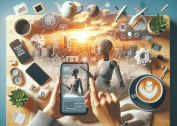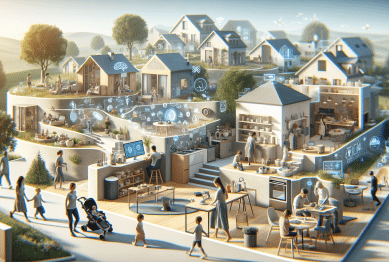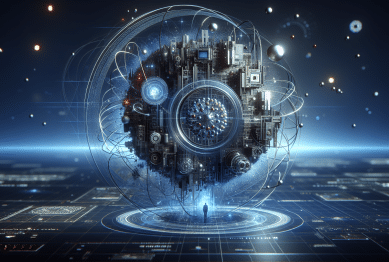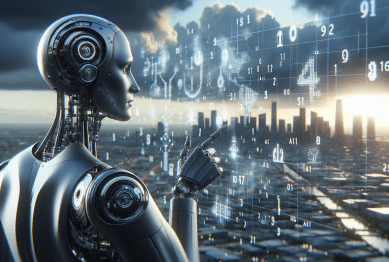AI isn’t just for experts. Discover how artificial intelligence already powers everyday apps, personal assistants, smart home tech, and even healthcare. This in-depth guide reveals surprising ways AI tools shape routines, boost convenience, and enhance decision-making behind the scenes.
The Hidden AI Layer in Daily Routines
Many people interact with artificial intelligence daily, often without realizing it. AI operates behind the interfaces of smartphones, social networks, and streaming platforms, quietly analyzing preferences and optimizing recommendations. This technology is woven deep into search engines and navigation apps, making tasks smoother for billions. For example, when entering a destination into a map app, advanced algorithms instantly suggest routes based on real-time data and user patterns.
The ways AI integrates with routine life continue to multiply. Smart spam filters in email flag suspicious content by learning from millions of examples, improving accuracy over time. Shopping assistants might recommend products uniquely suited to personal interests, turning data into actionable choices without fuss. In vehicles, AI helps with traffic predictions and even powers features like automated braking. These adaptations happen rapidly, yet invisibly.
As this background layer grows smarter, it creates lasting shifts in expectations around convenience, safety, and efficiency. It also subtly trains users to trust recommendations and automation to support daily routines. Much of this transformation is seamless; the average person rarely considers the advanced analytics that fuel their favorite apps and devices.
Individuals may not notice machine learning at work until a feature changes. For example, voice assistants—built from complex neural networks—grow more intuitive by processing millions of conversations. Each query, correction, or misunderstood word teaches systems to refine their understanding. The result is improved performance for personal virtual assistants like Siri, Alexa, Google Assistant, or others, making them feel more natural than ever.
On social networks, AI content moderation and news feed curation often determine which posts reach users’ screens. Algorithms adapt based on engagement, learning from likes and shares to present relevant updates or filter potential misinformation. Without being visible, these behind-the-scenes technologies affect interactions and information quality for everyone.
In many ways, the AI hidden in daily life is as common as electric lighting. It adjusts, improves, and becomes an essential—though often overlooked—support system for modern living.
The scale of AI’s reach grows quickly. Voice-to-text in smartphones relies on language models that understand regional accents and evolving slang. Streaming platforms use AI to suggest new music or shows based on viewing history and taste clusters across millions of users. Even smart thermostats apply predictive models to anticipate heating and cooling needs based on occupation patterns, weather, and real-time occupancy sensors. These routines have become so naturalized that many regard their efficiencies as normal.
The blending of advanced algorithms and personal data creates small time savings and smoother experiences that accumulate, influencing overall quality of life. Ongoing advances in this sector highlight the significance of artificial intelligence beyond the realm of specialists and technology fans. It matters for everyone who taps, swipes, and streams — whether they think about the technology or not.
Virtual Assistants: Your Everyday AI Helpers
Virtual assistants are among the most visible applications of advanced AI in consumer technology. These digital helpers respond instantly to voice commands, set reminders, play music, and even perform smart home operations. Their user-friendliness comes from deep learning, natural language processing, and constant upgrades shaped by millions of data points.
Voice recognition and semantic analysis form the backbone of assistants like Google Assistant, Alexa, and Siri. They turn spoken words into structured commands, interpret context, and access online databases to answer questions. From managing appointments to reading out the daily news, virtual assistants streamline multitasking for users of all ages.
The integration of AI assistants into smartphones, tablets, and smart speakers has unlocked more natural and flexible forms of human-computer interaction. These tools continue learning from every interaction, improving their ability to understand accents, dialects, and even user preferences related to phrasing and intent.
Natural language processing enables these AI assistants to engage in context-aware conversation. For example, when asked, “What’s the weather like tomorrow and should I bring an umbrella?”, the AI can combine multiple datasets—location, weather predictions, and calendar events—to provide relevant advice. Machine learning models adapt to recurring requests, gradually personalizing results to user routines.
Beyond smartphones and speakers, AI helpers are expanding into wearables, cars, and household appliances. Smartwatches and connected vehicles can relay messages, provide emergency support, or control climate settings—often triggered by simple voice instructions. This broadening ecosystem continues to make artificial intelligence a dependable everyday companion.
People are discovering that privacy and customization can be balanced as companies refine settings for data sharing and voice recording. This transparency is building more trust in the way AI-powered assistants operate.
With each update, virtual assistants gain abilities that once belonged to science fiction. They foster independence for visually impaired users by reading messages or transcribing spoken words. For seniors or people with disabilities, hands-free controls support accessibility in new ways. Developers are introducing AI-powered assistants into health monitoring devices, too, providing alerts or reminders when medication is due.
The key to these transformative applications lies in the adaptability of AI. As assistants become more proactive—offering reminders about traffic, suggesting healthy habits, or flagging calendar conflicts—they embed themselves ever deeper into day-to-day routines. This ongoing integration marks a shift in how people rely on technology, recognizing AI as a practical partner in busy lives rather than just a novelty.
Smart Home Systems: The Rising Standard
Smart home technology brings AI into the domestic sphere, automating tasks from lighting to security. These systems use predictive algorithms to manage everything from thermostat settings to appliance schedules. Their intelligence comes from analyzing occupancy, weather forecasts, and user preferences to boost comfort and save energy.
Products like smart thermostats, automated lights, and connected security systems all rely on AI-driven decision-making. Over time, the system learns the household’s habits and optimizes settings for both convenience and efficiency. These subtle automations make everyday chores a little simpler without drawing much attention.
As smart home ecosystems expand, interoperability between devices is improving. Major manufacturers are adopting standards to assure that lights, sensors, speakers, and security systems work harmoniously, regardless of brand.
Home security is another area transformed by advanced algorithms. AI-powered cameras distinguish between family members, guests, and unknown visitors. When unusual activity is detected, alerts are sent directly to users through mobile notifications or voice assistants. These measures not only improve safety but also offer peace of mind.
Beyond security and climate, many homes now feature connected cooking appliances, irrigation systems, and even robotic vacuums. These devices use artificial intelligence to sense clutter, identify surfaces, or time their actions according to daily routines.
New sensors and data fusion models mean that smart home technology can monitor air quality, detect leaks, and forecast energy consumption, all with minimal user intervention.
Adoption of smart home devices is fueled by their promise of increased comfort. For example, AI routines can prepare the ideal scene—adjusting lighting, music, and room temperature—at the press of a button or even automatically by presence detection. This kind of effortless personalization draws more households toward connected living.
As the AI layer strengthens, so do conversations around privacy, data security, and digital rights. Manufacturers and technology advocacy groups now focus on educating users about consent, customization, and transparency in smart home settings.
Reliable standards and secure protocols are shaping a future where the benefits of AI-powered automation can be widely enjoyed while potential risks are managed openly.
AI in Healthcare Tools and Wearables
Healthcare is leveraging AI to improve access, efficiency, and personalized care. Many medical apps and wearables now use machine learning to monitor vital signs and predict health trends before issues arise. From step trackers to advanced heart monitoring, these tools collect data constantly, using AI models to turn it into actionable wellness guidance.
For example, smartwatches not only count steps or track sleep cycles but can detect irregular heart rhythms or stress levels by analyzing continuous physiological data. If a risk pattern emerges, the device can encourage a health check, potentially supporting earlier intervention for users.
Many users enjoy a more proactive approach to healthcare thanks to AI, as guidance comes in simple, actionable feedback rather than overwhelming medical jargon.
Healthcare professionals are integrating artificial intelligence into diagnostic tools. AI algorithms can identify potential anomalies in scans or blood panels faster than manual review, freeing up clinicians for more complex decision-making. In hospitals, robots guided by AI assist with repetitive tasks or remote monitoring.
On the consumer side, mental health apps use chatbot therapists powered by natural language processing. These AI-supported consultations provide privacy, convenience, and early self-care options for people exploring mindfulness or stress management.
The rise of telemedicine platforms powered by AI triage systems also brings secure, rapid assessments, ensuring that those with urgent needs are prioritized for in-person consultations.
AI-powered health apps depend on robust data privacy frameworks and clinical validation. As these systems gain deeper access to sensitive health metrics, providers and regulators emphasize clarity about how data is used. Users gain tools to control their privacy, select what is shared, and understand how their information shapes AI-generated advice.
In the future, researchers expect AI to further individualize healthcare. Wearables may monitor nutrition, guide workouts, or provide reminders tailored to medical history. With constant improvements in algorithm transparency and accountability, the role of AI in personal health continues to evolve, bringing new opportunities for prevention and well-being.
Personalization and Predictive AI Across Platforms
Predictive artificial intelligence makes digital experiences more intuitive. Streaming services analyze what viewers watch, recording detailed behavioral patterns. AI models then suggest new movies or playlists, adapting as interests evolve. This tailoring now reaches news feeds, e-commerce sites, and even job search platforms.
Every online interaction leaves traces—search queries, clicks, ratings, and time spent. This data fuels the predictive power that turns generic digital spaces into custom dashboards. It simplifies choice, surfaces hidden gems, and shortens the time needed to find relevant content.
On social sites, feeds adapt in real time, surfacing trending topics based on community interests and personal history. These algorithms dynamically balance novelty with familiarity, keeping engagement high and users coming back regularly.
The same predictive patterns surface in ride-sharing and food delivery apps. AI routes drivers efficiently and adjusts wait time predictions as local conditions shift. For shoppers, personalized AI curates product lists and applies subtle incentives based on browsing and past orders.
Job-seeking tools now leverage artificial intelligence to match skills, experience, and location to relevant openings. Alerts recommend opportunities as they become available, reducing manual search efforts. These predictive engines continually refine themselves, improving user experience in the background.
Learning algorithms, often based on deep neural networks, are at the heart of every digital service that feels responsive and “smart” in adjusting to people’s needs.
This level of personalization has advantages and challenges. Well-designed AI systems filter information overload and deliver timely recommendations. However, it raises questions about transparency: how much of the user experience is curated versus organic?
Developers and platform owners have taken steps to add transparency and feedback controls. Users can now adjust recommendation settings, report inaccuracies, or learn what data influences their feed. Educational resources encourage digital literacy, empowering individuals to engage critically with automated suggestions and refine what they receive.
As digital environments become more tailored, understanding the underlying AI mechanisms helps people maintain control and balance in their online activities.
Future Directions and Responsible AI Use
The rapid evolution of AI tools brings new questions about transparency, ethics, and social impact. As algorithms make more decisions in the background, technologists, policymakers, and users must focus on responsible adoption.
Initiatives to promote open AI standards are underway. These aim to ensure that the benefits of artificial intelligence are distributed fairly and that risks are proactively managed. Discussions range from data privacy frameworks to ways of reducing algorithmic bias and ensuring accountability.
Involvement from user communities, educators, and consumer rights groups is essential in shaping how AI-powered systems evolve and serve society at large.
Ongoing collaboration across sectors supports safer, more transparent AI. Companies partner with academic institutions and regulators to audit AI behavior and limit the spread of misinformation. Ethical guidelines encourage the responsible development of smart assistants, recommendation engines, and healthcare applications.
Training resources for digital literacy, such as nonprofit workshops or online seminars, help users understand how AI works and what rights they have. Public understanding strengthens the feedback loop for continued innovation, helping creators refine their tools and adapt to diverse user needs.
As the technology matures, ongoing dialogue about fairness and inclusivity ensures all benefit from AI-driven progress.
The conversation about artificial intelligence is growing. From hidden helpers in apps to visible smart devices, the technology is part of everyday life for people everywhere. Prioritizing responsible design, ethical use, and ongoing public education can help close knowledge gaps and foster trust.
AI will not just remain in the background; it will become an even bigger force in shaping work, healthcare, and leisure. Staying informed and engaged allows everyone to navigate these developments thoughtfully, making smarter choices about how—and why—AI is used.
References
1. United States National Institute of Standards and Technology. (2023). Artificial Intelligence: A Strategic Vision. Retrieved from https://www.nist.gov/artificial-intelligence-strategic-vision
2. European Commission. (n.d.). Ethics guidelines for trustworthy AI. Retrieved from https://digital-strategy.ec.europa.eu/en/library/ethics-guidelines-trustworthy-ai
3. Harvard University. (n.d.). The Role of Artificial Intelligence in Everyday Life. Retrieved from https://sitn.hms.harvard.edu/flash/2020/role-artificial-intelligence-everyday-life/
4. Mayo Clinic. (n.d.). AI in Health Care. Retrieved from https://www.mayoclinic.org/tests-procedures/artificial-intelligence-health-care/about/pac-20484970
5. Consumer Reports. (2023). How Smart Home Devices Use Artificial Intelligence. Retrieved from https://www.consumerreports.org/electronics/smart-home/how-smart-home-devices-use-artificial-intelligence-a10648745311/
6. Stanford University Human-Centered Artificial Intelligence. (n.d.). AI and Society. Retrieved from https://hai.stanford.edu/policy-briefs/ai-and-society









